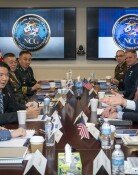[Opinion] Japanese Name-Changing
[Opinion] Japanese Name-Changing
Posted March. 01, 2005 22:31,
One of the worst actions imposed by the Japanese on Korea during the period of Japanese invasion and rule in the early 20th century was their name-changing policy. Instead of allowing the Koreans to keep their ancestral names, the Japanese forced Koreans to take Japanese surnames.
Vestiges of original names did remain: Kim was altered to Kaneyama, Lee to Linoie, and Paek to Shirakawa. Nam, Yoo, and Lim were left unchanged, however, as they corresponded to Japanese equivalents. But the name Shim of the Cheongsong district was changed to Aomatzu, and the name Suh of the Dalseong district was altered to Datzushiro, thus altering the district name as well as the last name. Those that refused to comply with the name changing policy amounted to about five percent.
The Japanese also altered the traditional regional names of the Joseon dynasty-
The organization Green Korea recently investigated the names of mountains, hills, and villages of 32 cities and provinces, which resulted in the discovery of 22 districts still carrying the remains of the Japanese name-changing policy. Prime examples of this are regions with the word wang (king when written in Chinese characters) to hwang or wang, (a Chinese character different from above), connoting the Japanese emperor. Inwang Mountain (mountain of the virtuous king) in Seoul was altered to Inwang Mountain (mountain of the virtuous emperor), and the Cheonwang Rocks of Sokri Mountain were changed to Cheonhwang Rocks. Inwang Mountain finally recovered its original name in 1995, 50 years after the independence of Korea.
Some names were altered for convenience regardless of the towns past history. Gooam-ri (turtle rock village) of Yanggu-gun, Gangwon Province, with its turtle shaped rock, and Gupyung (turtle chessboard) village of Hamyang-gun, South Gyeongsang Province, was altered to Gooam-ri (nine rock village) and Gupyung (nine chessboard) village. Yonggye (dragon rooster) Village of Jangsu-gun, North Jeolla Province, the region where General Lee Sung-gae was awakened by the cry of the rooster and won in a battle against the Japanese in the final years of the Goryeo dynasty, was altered to Yonggae (dragon stream) Village. Samgak (three points) Mountain, with its Baekwoon Point, Insu Point, and Nojeok Point, was changed to Bukhan (North Korea) Mountain, simply because of a corresponding Namhan (South Korea) Mountain in the South.
The Japanese also planted metal stakes on mountains and robbed pottery containing the remains of umbilical cords in the gravesites of kings, fueling rumors that that the Korean peninsula did not produce a great figure because the Japanese disrupted the harmony of the mountains of Korea nationwide during the Japanese Imjin Invasion. We again commemorate the sufferings of our race on Independence Movement Day.
Oh Myung-chul, Editorial writer, oscar@donga.com







